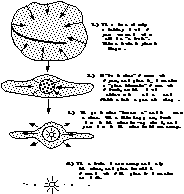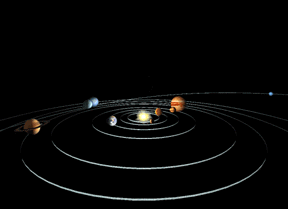Exploratour - Evolution of the Solar System
Click on image for full size
C. Alexander
Because the cloud was spinning, it flattened into a frisbee shape, just like a ball of pizza dough becomes flat when a chef spins it in the air. The frisbee shaped cloud grew hotter and denser in the center, with a disk of gas and dust surrounding it that was cool.
As the cloud flattened, the gaseous material inside was forced to begin changing into solid form. These little particles of solid material were warm, soft and sticky, and whenever they touched each other, further clumped together to form larger balls of solid material somewhat the way pieces of "silly putty" would stick together if they came into contact. The hot and dense part in the center we call a proto- sun, meaning that it was a forming sun. It was not a star yet, but eventually would become our Sun. The large balls of clumpy stuff, which could be boulder sized to asteriod sized, we call "planetismals", meaning that they were miniature planets. Eventually only a few large clumps of this material remained in the forming solar system, and they became the core of "proto-planets".
This is page 6 of 60












